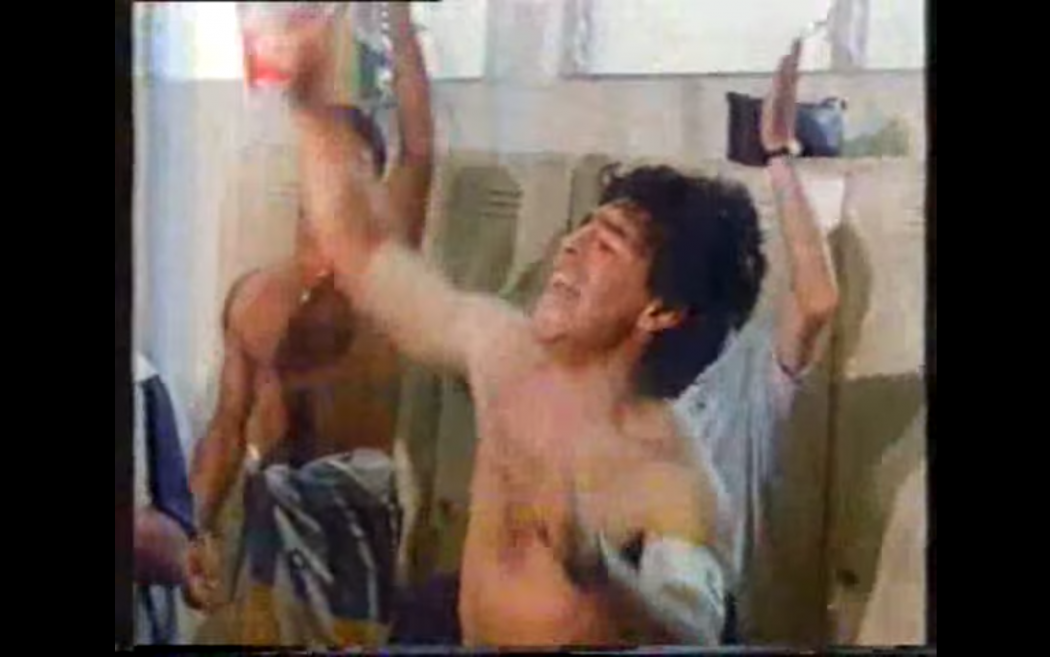“Hero” shows the myth of Maradona being made

Diego Maradona shimmies and jukes. He drags the ball with him. The camera pans from his feet to his face, tracking him as he goes. Is he heading toward the goal or dribbling harmlessly across the field? I can’t tell, and neither can the English defenders he slides by so easily. The goalkeeper is nothing more than a gray blur but he gives me my bearings, and in the next instant I see the familiar toe poke. The screen goes black and then up flash the opening credits of Hero. When Maradona reappears, he’s running toward the corner flag, celebrating the most famous goal in World Cup history.
Hero subscribes to the Great Man theory of soccer. There’s no “I” in team, but there is in Francescoli, Platini, Lineker, and Rummenigge, whose names follow Maradona’s in the opening credits, along with Elkjaer, Butragueño, Sócrates, Laudrup, and Sánchez. These are the actors, and the filmmakers use them, rather than their teams, to tell the story of the tournament in Mexico.
El Diego’s dominance made this the obvious choice. More so than in any other World Cup, the winning team, Argentina, is associated with the brilliance of a single player. Camera work in the film reflects this, staying tight on each of these Great Men for minutes at a time, stripping them of context but offering something else: a glimpse of Gary Lineker’s movement in the box or, in the moment he languidly chips the keeper, proof that Michel Platini experiences time differently than the rest of us. We notice Maradona’s balance and speed with the ball, which in 2014 can only be described as Messi-esque.
Legendary keyboardist Rick Wakeman works with Michael Caine, the narrator, to create moods for the actors. Enzo Francescoli is dark, dangerous: “Against Denmark, a nightmare unfolds for the Prince.” Cue an extremely dramatic synth beat. We meet Platini and you get the message: he’s a heartthrob, but maybe a little sad. Maradona, all throbbing heart, plays to his own triumphant track.
Hero is so good partly because it was made toward the end of soccer’s most cinematic era. The game followed the same 20th-century trajectory as most other forms of popular entertainment, trending toward spectacle and celebrity culture, but it hadn’t quite arrived in 1986. We know now that the World Cup was becoming a TV show — sanitized, scalable, the only difference in broadcasts years apart, from Seoul and Durban, being the hemline of the players’ shorts. For Brazil ’14, instruments will be banned from stadiums. The country that made soccer musical will sound exactly like everywhere else. Those forces were already at work in 1986, but they weren’t strong enough to keep music out of Estadio Azteca, much less the fans from staging a joyous pitch invasion after Argentina won the final.
Besides, everything looks better at 24 frames per second. Soccer in the film is recognizable but different. The uniforms are simpler and more beautiful. Everyone wears black shoes. Players get tripped and, astonishing to the modern viewer, they don’t fall down. Goals are celebrated not with a trademarked gesture to the cameras but earnestly, with teammates, as though the cameras are not even there.
Editor’s note: This essay appeared in Howler Issue 05 under the headline “Men at Play.”
